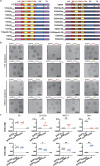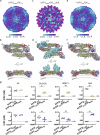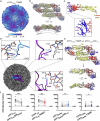A single residue in the yellow fever virus envelope protein modulates virion architecture and antigenicity
- PMID: 41006244
- PMCID: PMC12475062
- DOI: 10.1038/s41467-025-63038-5
A single residue in the yellow fever virus envelope protein modulates virion architecture and antigenicity
Abstract
Yellow fever virus (YFV) is a re-emerging flavivirus that causes severe hepatic disease and mortality in humans. Despite being researched for over a century, the structure of YFV has remained elusive. Here we use a chimeric virus platform to resolve the first high resolution cryo-EM structures of YFV. Stark differences in particle morphology and homogeneity are observed between vaccine and virulent strains of YFV, and these are found to have significant implications on antibody recognition and neutralisation. We identify a single residue (R380) in the YFV17D envelope protein that stabilises the virion surface, and leads to reduced exposure of the cross-reactive fusion loop epitope. The differences in virion morphology between YFV strains also contribute to the reduced sensitivity of the virulent YFV virions to vaccine-induced antibodies. These findings have significant implications for YFV biology, vaccinology and structure-based flavivirus antigen design.
© 2025. The Author(s).
Conflict of interest statement
Competing interests: N.D.N., R.A.H., J.H.-P. and D.W. are inventors on patent application WO/2018/176075, relating to the chimeric BinJV platform. The remaining authors declare no competing interests.
Figures






References
-
- Monath, T. P. & Vasconcelos, P. F. C. Yellow fever. J. Clin. Virol.64, 160–173 (2015). - PubMed
MeSH terms
Substances
Grants and funding
LinkOut - more resources
Full Text Sources

